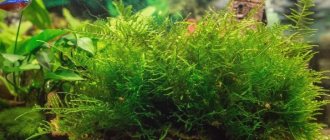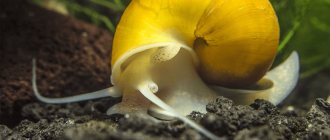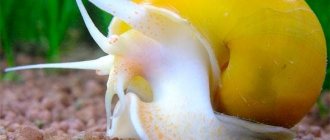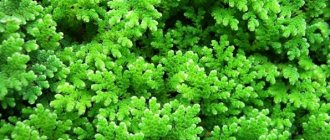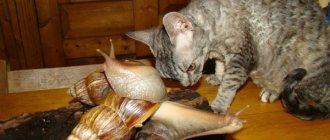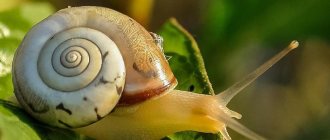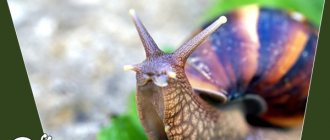10/11/2019Pisces0
Lamprologus is a Tanganyika freshwater cichlid that has a limited range, is unpretentious in keeping and is therefore suitable even for beginners. Attractive with his peculiar behavior.
- 1 Description and natural habitat
- 2 Mr. Tail recommends: variety of species
- 3 Basics of aquarium keeping
- 4 Compatibility
- 5 Feeding
- 6 Breeding
Habitat
Endemic to Lake Tanganyika in Africa, it is the second largest lake in the world.
Located on the border of four states: Democratic Republic of the Congo, Tanzania, Burundi and Zambia. This species is found everywhere, preferring regions with sandy substrates along the coastline, dotted with empty mollusk shells. Brief information:
- Aquarium volume - from 40 liters.
- Temperature - 23–27°C
- pH value – 7.5–9.0
- Water hardness - medium to high hardness (10–25 dGH)
- Substrate type - sand
- Lighting - moderate
- Brackish water - no
- Water movement - weak, moderate
- The size of the fish is 3–6 cm.
- Food - any sinking food
- Temperament - relatively peaceful
- Keeping in a male/female pair or harem type
Mr. Tail recommends: variety of species
There are more than 45 species of Lamprologus in nature. The table shows the most common ones.
| View | Description and length (cm) |
| Brown | The color is beige with bluish-green sparkles. The belly has fan-shaped fins. Until 8. |
| Neolamprologus signatus | Red with dark red stripes, fins with peculiar patterns. Elongated body. Steel-colored gills. Up to 5. |
| Kungwe or Lamprologus kungweensis | Color – brown-beige, light gray with a purple tint. It has jaws with pointed teeth, large eyes with blue irises, and yellow rounded fins. 4. |
| ocellated | It has a cream body with rounded fins, along which there are 3 rows of shiny scales, and an orange row from the middle part to the caudal fin. The soft-rayed part of the anal and dorsal fins are edged with white. There is a black or emerald green spot on the gill cover. 6,5. |
| Stappersea (star shell) | Brown with white dots all over the elongated body with purple-tinged sides. 6. |
| Speciosus | Dark brown, iridescent in the light with violet-blue colors. The fins are yellowish and translucent. 5. |
| Orange or leleupi | The fish are golden, orange, blackish with light dots of tones. Slightly oblong. It is demanding on the size of the aquarium (minimum 50 l). To 10. |
| Calvus (butterfly, mother-of-pearl fairy) | Dark gray, black with white, golden, shiny dots with stripes throughout the body. 10-15. |
| Ocellatus gold | Golden in color with spots glowing violet and a pearlescent belly. 5,5. |
| Similis | Brown with delicate light stripes. 3-4. |
| Lamprologus multifasciatus | The smallest type. Bright beige with frequent black stripes. Until 3. |
| Compressiceps (compressed head) | Yellow head. The fins are red. 14. |
| Congolese or lionhead | It can be lilac-gray, light brown in color with silver specks. The locomotor organs (fins and tail) are covered with gold and blue dots. 8. |
| Neolamprologus brevis | Green-brown with stripes all over the body. Aggressive type. 6. |
| Caudopunctatus | Speckled tail. The dorsal fin is yellow-orange. Whitish with silver dots, turquoise blue. 6. |
| Callipterus | Very fast swimmers. Brown of different saturations. 12,4. |
| Neolamprologus boulengeri | Rich color, reproduce well, very active. 6. |
Maintenance and care, arrangement of the aquarium
The optimal size of an aquarium for one pair of fish starts from 40 liters. The design should include open sandy areas with a soil depth of at least 5 cm (the fish likes to dig in the sand) and many hollow snail shells. Lamprologus ocellatus uses them as shelter and spawning sites, in addition to being the center of their territory. The remaining decorative elements are chosen at the discretion of the aquarist. The presence of plants is not necessary, but you can use them if you wish. However, you should choose unpretentious species that can grow in hard and alkaline water. When keeping it, it is important to ensure stable water conditions with suitable pH and dGH values and not allow fluctuations in nitrogen compounds (ammonia, nitrites, nitrates). The key is a productive filtration system, regular cleaning of the aquarium from organic waste, and weekly replacement of part of the water (10–15% of the volume) with fresh water.
Planet TANGANYIKA
Lamprologus caudopunctatus (Poll, 1978), caudopunctatus (from lat.) – speckled tail
These lamprologus are sure to attract the attention of the Tanganyikan cichlid lover. I will call caudopunctus ideal lamprologi, even if I step on the throat of personal preferences among Lamprologini. Because, if assessed objectively, Lamprologus caudopunctatus has almost no “weak” points:
Lamprologus caudopunctatus - owners of attractive colors
Everyone, of course, has their own tastes, but, whatever one may say, speckled tails cannot be denied elegance. Delicate, pastel colors, grace. The main noticeable feature of the species is the high dorsal fin with a beautiful orange trim along the edge. It is rarely seen pressed to the body; the crest is always proudly straightened and this is an indicator of the good health of Lamprologus сaudopunctatus. An openwork mesh of scales with silver-blue sparkles is draped over the whitish body. According to the name of the species, the specks extend to the fins. The iridescent turquoise eyes, in my opinion, are very expressive. It is extremely rare that six wide transverse stripes may appear on the body, which happens in moments of severe territorial confrontations, or in another stressful situation:
The coloring of females and males is absolutely the same. Already 2 - 2.5 cm, the juveniles replicate their parents in miniature, except that the brilliant scattering of sparkles is not yet visible on the small, narrow body. But it already exists! And further. Lamprologus caudopunctatus resembles Xenotilapia spilopterus Mabilibili in color, doesn't it?
Lamprologus caudopunctatus - owners of highly developed parental instinct
Hence a whole complex of interesting behavioral reactions. Such fish are considered to be the intellectuals of the underwater world and no wonder, because speckled tails are actively engaged in their offspring from the very “start” and do not abandon them much later. Speckled tails walk the fry, gather them into a flock, and in case of danger they actively protect them. It was during this period of my life, at the beginning of the two thousandths, that I first saw a pair of Lamprologus caudopunctatus at my friend’s place in Moscow. Subways and train stations are always a challenge for me, but when you go to a friend’s house to look at and discuss new fish, it makes up for everything.
About an hour in the human Gulf Stream and I am immersed in a wonderful aquarium atmosphere. Twilight, luminous “windows” of aquariums, the whisper of air bubbles - the soothing lounge of a cozy aquarium farm. All around are “behavioral” fish and familiar, recognizable interiors - large and small stones, shells, pipes, pots. You instantly forget that you are almost at the very “epicenter” of a giant metropolis. I find caudopunctus in a small trough aquarium at the very top of the aquarium stand - it’s calmer here. A couple of Speckled Tails and a small cloud of “Tailed Dots” above the ground. Parents to the right and left of the flock are very attentive, sometimes they catch “fugitives” and return them to the flock. It’s funny how they examine individual fry, bringing their moving blue eyes close to them. I watch them, and they, out of the corner of my eye, watch me. I carelessly raise my hand - the little one “sat down”, and the big ones recoiled slightly, becoming covered with dark, alarming stripes. Their tails are lifted up, stand upright and look at me from under their brows. Well, well, guys, I won’t do it again!
In general, the behavior of Lamprologus caudopunctatus with fry in a separate aquarium is very similar to the behavior of Tanganyikan princesses - the standards of parental love and devotion. Once upon a time, a family of caudopuctatus received 250 liters for about six months. aquarium. A fry appeared, did not set aside, the caudopunctatas spawned again, and then again. Gradually, a colony of a good hundred different-sized offspring was organized in the aquarium. This can often be observed among the princesses of Burundi. The same behavior, the same social organization. Here, it must be said that the coloniality of the princesses of Burundi is simply “advertised” more, but “community” or something similar to it is possible in the aquarium of many lamprologus.
Close to the shell lamprologus in size, Lamprologus caudopunctatus displays in the aquarium the entire set of habits characteristic of “true shell fish”.
And, I’ll take the liberty of saying, they are going further in some areas. Passion, how they love to tinker with sand! They dig up energetically, take out the sand, move it away, and unfold the shell as needed. In the best “shell traditions,” they disguise the “shell house” with sand and ram the soil from it in different directions, as a result of which the shell ends up on top of the sand mound. Same as shellfish, but larger.
They master the technique of “preserving” excess shells, that is, completely covering with sand shells that are not “covered” by attention today (with possible subsequent “re-preservation”). This is typical of individualistic shellfish - Speciosus, Ocellatus, Meleagris. Having spawned, the female speckled tail can “go” deep into a large shell to the clutch for a very long time. Once I didn’t see her for two days and considered her already lost... Then, nevertheless, I discovered that she was “bruised” from sitting inside for a long time and had lost weight. In a shell cavity the size of a small apple, tiny fry swarmed - it was a pleasant surprise. In general, we can safely say that caudopunctus embodies everything that we love so much about the “cave” and “shell” Tanganyika - complex, extremely interesting behavior. Excavation in an aquarium with fine sand "red line" goes through the entire life of the speckled tail. Looking at the scientific zeal with which speckled tails dig and study spiral cavities, you wouldn’t think that they spawn in caves in the lake. However, this is true. If only there were shells of the right size in Tanganyika!
Who's who in a community aquarium with Lamprologus caudopunctatus
As devoted parents, speckled tails are able to give a tough rebuff to fish that pose a danger to their offspring. During the spawning period, as a rule, the strength of the fish doubles and those whom the speckled tails were afraid of before spawning may also turn to flight. At the same time, Lamprologus caudopunctatus is still not as “territorially aggressive and assertive” as the Tanganyikan princesses, which provides more opportunities for combining the population of the aquarium. Quite miniature sizes also play a significant role. If I were to imagine a five-point scale of territoriality, I would give Lamprologus caudopunctatus a four with a minus. Four - for fighting spirit and assertiveness, minus - for objectively small size. They are definitely “number one” in terms of combativeness among Lamprologus, but “one to one” they are inferior to neolamprologus, julidochromis, they will not give way to altolamprologus of similar size, but they will give way to adults. Definitely weaker than short-bodied Telmatochromis, but they can “twist ropes” from long-bodied ones... Tested over a long period of time and a variety of shared content options. In a large aquarium, by combining the age, size of different species, and readiness to spawn, you can “launch” a viable community with neolamprologus, where speckled tails will successfully withstand the pressure of potentially stronger neighbors.
Geography of distribution of Lamprologus caudopunctatus
Wide enough. According to information from Ed Koenings, populations of the species were found at Kapampa and Moliro - on the Congolese coast, at Kasanga and Chituta in Zambia, in Tanzania - at Kala, the island of Mamalesa and the village of Kisambala. It is very likely that in the process of studying the lake, the list of “places of deployment” of speckled tails will be added. One way or another, among the available list, the focus of attention of aquarists is the Georas Kapampa (Congo), which surpasses the rest in beauty. In European price lists it is listed under the commercial name “orange fin” Kapampa. The remaining geovariants are extremely rarely the object of commercial fishing. And the “kapampa” itself is not often caught, since caudopunctus breed well in aquariums.
The same “fate” befell an extremely close and rare species - Lamprologus leloupi (pictured left)
← photo www.allfishes.net
Lamprologus leloupi. so similar to Lamprologus caudopunctatus that they can easily be confused. One would like to classify leloupi (you immediately remember leleupi) as a caudopunctatus, but scientists, guided by morphometric data, counting “vertebrae and bones,” think otherwise. The lake periodically presents scientists with such “surprises” and, it seems, more advanced approaches are required in determining species identity.
Size of Lamprologus
caudopunctatus and sexual differences
The first effective spawnings, according to my observations, occur when males are at least 4.5 cm in size and about a year old. In an aquarium, in good conditions, males can grow up to 7 cm in a few years. Females lag behind by about a centimeter. More often, aquarists deal with 5-6 cm individuals who are “in the prime of life”; you rarely see over-aged 7 cm males. In the lake, the caudopunctus are even a centimeter larger, but what is this centimeter worth! In an aquarium, he could change the “status” of caudopunctus, allowing them to become equal to julidochromis, for example, and maybe even surpass them. Very likely they could “get into” the “heavy” weight category, among the neolamprologus! And what? The fighting spirit of speckled tails is on par, add “mass” and that’s all.
At first, in a young pair of caudopunctates, sexual differences are very weakly noticeable, often not even noticeable at all. The size and color of the fish are absolutely the same. In practice, aquarists rarely use sex determination based on the structure of the genitals. An observant aquarist does not need this; the fish will “tell” everything themselves. Gradually, with age, the male “breaks away” from the female by about a centimeter. He is larger, noticeably more massive, and has a small fatty growth on the back of his head. The caudal fin of older males is marked at the top with an orange edge, as if transferred here from the dorsal fin. Females that have brought offspring more than once have a slightly more convex line of the abdomen before spawning.
1.5-2 year old female (left) and male
To create a harmonious family of caudopunctus, traditionally, a group of young fish is raised together, from which pairs are subsequently separated. In a large community aquarium, small harems can exist.
Lamprologus caudopunctatus in general and in a species aquarium
They are a wonderful addition to a variety of communities; there is no point in listing the options, the reader knows very well that there are countless of them. Speckled tails are capable of “holding a punch” in a very tough neighborhood; an adult family firmly “settled on the nest” is not a gift for anyone. I supplemented aquariums with neo- and lepidiolamprologus with caudopunctus when I wanted something “shell-like” for the “team”. Attachment to the shell is convenient to use in “teams” with more loyal fish. The same xenotilapia, for example. By placing the shell in a corner, we thereby limit their “sphere of influence.”
Keeping fish like Lamprologus caudopunctatus in a species aquarium is a special topic for me personally. These are extremely “behavioral” and cozy fish. I once came up with the phrase “desk aquarium” not by accident. Since elementary school, on my large desk on the right there was an aquarium with swordtails and catfish. Later, it was replaced by an aquarium with the first “shellfish” - multifasciatus. On the left is a computer monitor, on the right is an aquarium, do you remember the “fashion” of placing a cactus near the monitor? If this really works to your advantage, then the aquarium is an order of magnitude better in this sense.
A species aquarium with caudopunctus is the same theme as species aquariums with caring cichlid parents or Tanganyikan princesses. Parents with fry always look excellent, coloring is “at maximum”, behavior at these moments is especially meaningful. To be honest, you won’t see “family idylls” in a common aquarium; there the fish would have their own “corner”…. And in the species - the whole set of habits. Pairs of caudopunctus are friendly; in a “personal” aquarium, the same ocellatus, speciosus, and meleagris (who like to lie by the shells) are an order of magnitude more active. An aquarium with a pair of speckled tails looks full and self-sufficient, as they often harbor young fish.
Lamprologus caudopunctatus. Family organization
Since I said above about the remarkable content of a pair of caudopunctus with a fry, I will say that they are far from monogamous, they are much more flexible in this matter. In the territory of a sexually mature male, all mature females will be “covered”. In one of my aquariums, a male managed to control three females at once and each of them brought offspring. Spawnings occurred almost synchronously, with a difference of no more than a day. was due to a considerable number of competing species and due to the fact that individual nests with females were located at a great distance from each other. It turned out to be impossible to observe the “harem” in a species aquarium for a long time due to fierce competition between females. Ultimately, the “beloved wife” remained with the male.
Decorating an aquarium with Lamprologus caudopunctatus
Lamprologus caudopunctatus live in the rocky and transitional zones of Lake Tanganyika and the aquarist who wants to bring his aquarium closer to the natural model has a wide choice of setting options. The same goes for decorative elements. It makes little sense to describe the decoration of an aquarium for speckled-tailed lamprologus. You already know everything: plenty of shelter, plenty of free space for swimming... It is up to the aquarist to choose whether to place shells or not. If you follow the “natural model” exactly, you will need to practice “construction” or look for suitable stones and not even put in authentic Neothauma. Because any stones you have are very likely to be rejected. I once observed how a female speckled tail “stuck” halfway into a Neothauma. The tail and part of the body jutted out comically, but the fish did not want to leave the shell for half a day. Aquarium caudopunctus love shells, that's not the word. They know better than us what they need, can you blame them for that? Speaking about freedom in choosing decor, a few words about the soil. Ultimately, which sand to use is not a matter of “life and death.” Pebbles and large stones will do, and you can generally do without soil. It’s just worth considering that caudopunctatas tinker with sand and shells just as well as shellfish, and it’s much more interesting to follow the life of “caudas” on fine sand.
Feeding Lamprologus caudopunctatus
In nature, L. caudopunctatus feeds primarily on zooplankton. In an aquarium, caudopunctus accept daphnia, cyclops, and brine shrimp equally well, and they take koretra very well. With some caution, I sometimes feed them with high-quality bloodworms and seafood products. Easily adapts to any dry food, without being tied to a specific brand.
Spawning of Lamprologus caudopunctatus
The fish mature when they reach approximately 4 - 4.5 cm. The eggs are glued by the female near the entrance to the shell or cave, so that sometimes a fragment of the masonry is visible. The eggs of L. caudopunctatus are slightly yellowish and very small, about 1 mm in diameter. The clutch of good breeders is resistant to mycosis, therefore, like the princesses of Burundi, in the aquarium it is possible to obtain an almost one hundred percent “yield” of fry without doing anything to preserve it. The speckled tails will do everything themselves
About the “weak” points of Lamprologus caudopunctatus
Ease of breeding and high productivity always negatively affects interest in fish, no matter what positive qualities they have. Once a new fish appears everywhere, the wave of popularity fades and sometimes this can lead to the disappearance of a species from aquariums. This does not happen with Lamprologus caudopunctatus. The small but devoted “audience” of Tanganyika lovers does not forget the caudopunctus - the most interesting representatives of the genus Lamprologus with delicate attractive colors and an enchanting set of habits. You will see all this when Lamprologus caudopunctatus starts arranging one of the shells in your aquarium to give birth to dozens of new lamprologus.
Text and photographs by Igor Shelestov
For all connoisseurs of Tanganyikan ichthyofauna
Behavior and Compatibility
A territorial species that will defend its small area on the bottom from the encroachments of relatives and other fish. First of all, this applies to the male. In a small tank, it is recommended to keep only one male in the company of one or more females. It is possible to combine with species that live in deep water or near the surface, such as Cyprichromis leptosoma. In a spacious aquarium, it is acceptable to keep with other territorial fish (for example, Julidochromis), provided that there is enough space for the alpha males of each species.
Breeding/reproduction
Shells play an important role in the reproduction of Lamprologus ocellatus, serving as a spawning site. Breeding is recommended to be carried out in a separate tank in the absence of other species - this significantly increases the chances of survival of the offspring. Unlike many other fish, females take the initiative in reproduction. With the onset of the mating season, they each lay eggs in their own shell and begin to invite the male. When they accept courtship, fertilization occurs. Females remain near the shell to protect the clutch. The male no longer participates in caring for the offspring. The incubation period lasts about 3 days, after another 10 days the fry begin to swim freely and begin to move away from their shelter. When the young reach a certain size, the female drives them out of the shell, and from that moment she is ready for a new stage of procreation.
Lamprologus multifasciatus
Neolamprologus multifasciatus multistriate . Lake Tanganyika, Tanzania, Zambia.
Description
Male 4 cm, female 3 cm. The smallest of the shell lamprologists. It has an elongated, low body, slightly flattened laterally. The caudal fin is slightly rounded. Distinctive features of this species of cichlids are: a compact build and a body flattened on the sides, a small head with a slightly upwardly located mouth, dorsal and anal fins rounded at the ends, pointed, non-elongated ventral fins; rounded tail.
The coloration is characterized by the presence of many dark transverse stripes on a light brown background and yellow-orange edging of the fins. The body is brownish-yellow to light beige, with 14-17 vertical dark stripes running along it, they begin behind the gill cover and extend to the dorsal and caudal fins. Fins with a pronounced blue. The male is larger and has a brighter color.
The fry differ in color from their parents in that their dorsal fin is equipped with a yellow border, but when the fish reach sexual maturity, this border disappears. Very similar to N. similis. You can notice that in addition to differences in the color and shape of the stripes, one of the main external differences is the striping of the head. Similis also has stripes on its head, while multifasciatus has no stripes on its head.
Content
Peaceful, small fish, for this reason it is better to keep fish separately. Keep in a pack with a predominance of females. An aquarium for keeping this species must have a large bottom area with a sufficient number of shelters with empty shells. The shell serves both as a shelter from enemies and as a spawning place for nurturing offspring. But you can do without sinks - to do this, place small pieces of slate on top of each other and cover them with fine gravel. The fish dig up this structure and make small caves and crevices in it, which serve them well instead of shells. Once in the aquarium, the fish immediately occupy the shells and then split into pairs.
The territory where the male and female are located is a hole dug by them, sometimes to the very bottom of the aquarium, in which shells lie. In one of them, the female lays eggs and cares for the offspring. When alarmed, fish hide in the shell, but not in the one where the fry are. Excess fish should be removed, otherwise clashes between males will constantly occur. It is possible to form a harem of one male and several females, which can occupy a whole bunch of shells.
Reproduction
A very prolific species. If the shell is large enough, the male and female will live together in the shell and raise several generations of young per year. Adult fish and fry of different generations stay in the same territory, living peacefully with each other. As a rule, representatives of this species live in colonies of up to 20 individuals, forming distinct family pairs, and each spouse has his own personal shell house, and the males periodically visit the females. Unpaired individuals form new family colonies. Females remain near the shells and guard eggs and young, while males protect the colonies. The young remain near the shell for the first four to six weeks. And then the fry settle around in holes in the sand, which their parents dig for them.
Fry can be raised in a community aquarium. Sandy soil with a grain size of 1 mm and a layer of 5 cm; place empty snail shells on it in different places, and their number should exceed the number of fish. Plants are planted at the back or side walls, but in no case in the immediate vicinity of shells or stone structures. Small thickets provide shelter for subdominant individuals and juveniles. They feed on live food; they are especially willing to eat cyclops, bloodworms, coretra and enchytraeus. T 23-25°C; dH 8-25°; pH 7.5-9.0.
Fish diseases
The main cause of most diseases of cichlids from Lake Tanganyika is unsuitable housing conditions and poor quality food, which often leads to a disease such as African bloat. If the first symptoms are detected, you should check the water parameters and the presence of high concentrations of hazardous substances (ammonia, nitrites, nitrates, etc.), if necessary, bring all indicators back to normal and only then begin treatment. Read more about symptoms and treatment methods in the section “Diseases of aquarium fish”.
"Lamprologus" similis Büscher, 1992
Breeding conditions (temperature, water chemistry, etc.) are somewhere in the middle of the range preferred by this species, characteristic of the waters of Lake Tanganyika. Preparing suitable water is rarely a problem. As a starting point, you can take 25-26C, pH 7.8-8.3 and hardness from 10 to 28 dGH. However, an essential element for most shell lamprologus species is the provision of a sufficient number of empty shells of suitable size. If you want to create a real colony of shell cichlids, then you need to provide at least five more shells than there are fish in the aquarium. Most species of barnacle lamprologus will continue to reproduce until the aquarium is “fed up” with offspring and mature pairs ready for breeding. Once this stage has been reached, you can simply dilute the population by removing a few shells containing fry and large fish, and replace them with empty shells, while starting another colony in a new aquarium.
My similis did not grow quickly, but by seven to eight months, with water changes, I could already fully enjoy the good colors of the shell rocks, which were nevertheless inferior in color to Lamprologus ocellatus “Nkamba bay”. Spawning followed unexpectedly. After another change of water, one of the females became clearly more active than the others and began to rush from one shell to another, the males (as it seemed to me) looked at this commotion in bewilderment. But finally, the female spotted one of the shells in the territory of the not-so-large male and began to clear it. Vibrating her whole body, she climbed her head into the shell and everything that was inside flew out of it. She also helped herself with her mouth, taking out all sorts of garbage that had accumulated in the cavity of the shell. All this time the male did not take any part in this work. He only floated nearby and even as a guard, his behavior could not be called. But when the female's work was finished, he approached the shell. By that time, the female appeared on the surface less and less and spent time inside the empty shell. Then it was the male’s turn; he lay down on the hole with his stomach several times, fixing himself on the current from the filter with his powerful pectoral fins, and seemed to stick to the hole in the shell. Then he took an inclined position of his body, as if looking inside the shell. Spawning ended as suddenly as it began. After spawning, the female practically never came out of her shell, only to grab a coret floating by, but she returned to her place with lightning speed. Subsequently, when the fry appeared, the female cleared the area around the shell, as some Western authors believe, this is done to maximize the penetration of plankton into the shell area under the influence of currents. Watching her work, it was not clear how the female took into account the “aerodynamics” of the process, but when the fry appeared, a small vortex was actually created near the shell, thanks to which the Artemia nauplii seemed to hover over the place where the juvenile lamprologus were grazing. The offspring of Similis are not numerous, usually 5-15 fry, and even less in young individuals.
